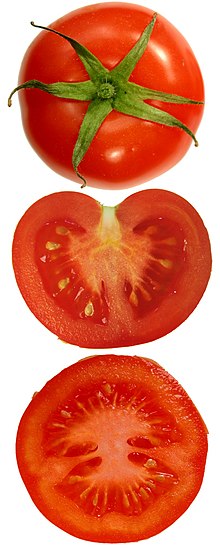
Back Атомат Abkhazian Trueng kléng ACE Tamatie Afrikaans ቲማቲም Amharic Tomato AMI Solanum lycopersicum AN Wulfpersoc ANG طماطم Arabic اوطه ARZ Solanum lycopersicum AST
| Tomato | |
|---|---|

| |
| Scientific classification | |
| Kingdom: | Plantae |
| Clade: | Tracheophytes |
| Clade: | Angiosperms |
| Clade: | Eudicots |
| Clade: | Asterids |
| Order: | Solanales |
| Family: | Solanaceae |
| Genus: | Solanum |
| Species: | S. lycopersicum
|
| Binomial name | |
| Solanum lycopersicum | |
| Synonyms[1] | |
| |

The tomato (/təmeɪtoʊ/ or /təmɑːtoʊ/) is the edible berry of the plant Solanum lycopersicum,[1][2] commonly known as the tomato plant. The species originated in western South America, Mexico, and Central America.[2][3] The Nahuatl word tomatl gave rise to the Spanish word tomate, from which the English word tomato derives.[3][4] Its domestication and use as a cultivated food may have originated with the indigenous peoples of Mexico.[2][5] The Aztecs used tomatoes in their cooking at the time of the Spanish conquest of the Aztec Empire, and after the Spanish encountered the tomato for the first time after their contact with the Aztecs, they brought the plant to Europe, in a widespread transfer of plants known as the Columbian exchange. From there, the tomato was introduced to other parts of the European-colonized world during the 16th century.[2]
Tomatoes are a significant source of umami flavor.[6] They are consumed in diverse ways: raw or cooked, and in many dishes, sauces, salads, and drinks. While tomatoes are fruits—botanically classified as berries—they are commonly used culinarily as a vegetable ingredient or side dish.[3]
Numerous varieties of the tomato plant are widely grown in temperate climates across the world, with greenhouses allowing for the production of tomatoes throughout all seasons of the year. Tomato plants typically grow to 1–3 meters (3–10 ft) in height. They are vines that have a weak stem that sprawls and typically needs support.[2] Indeterminate tomato plants are perennials in their native habitat, but are cultivated as annuals. (Determinate, or bush, plants are annuals that stop growing at a certain height and produce a crop all at once.) The size of the tomato varies according to the cultivar, with a range of 1–10 cm (1⁄2–4 in) in width.[2]

- ^ a b "Phylogeny".
Molecular phylogenetic analyses have established that the formerly segregate genera Lycopersicon, Cyphomandra, Normania, and Triguera are nested within Solanum, and all species of these four genera have been transferred to Solanum
- ^ a b c d e f "Garden Tomato. Solanum lycopersicum L." Encyclopedia of Life. Retrieved 1 January 2014.
- ^ a b c "Tomato". Encyclopaedia Britannica. 4 January 2018. Retrieved 15 January 2018.
- ^ "Tomato". Etymology Online Dictionary. 2018. Retrieved 15 January 2018.
- ^ "Tomato History". Retrieved 27 July 2017.
- ^ Cite error: The named reference
flemingwas invoked but never defined (see the help page).
© MMXXIII Rich X Search. We shall prevail. All rights reserved. Rich X Search